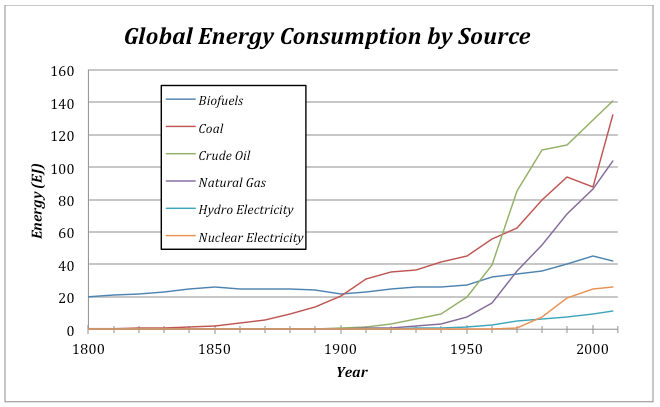Demand for energy varies with the time of year and the time of day. Between 2005 and 2030 energy needs are projected to expand by 55 per cent with demand increasing from.

Global Energy Sources Earth 104 Earth And The Environment Development
This interactive graphic based on research from the McKinsey Global Institute calculates energy and oil demand in 2010 2015 and 2020 using key variables such as energy productivity and GDP growth.

. MEDCs Demand for energy is not rising as rapidly in MEDC countries. Between 1982 and 2007 it increased by 60 There are several reasons for this increase. Most important among these variables are GDP growth regulation and technology breakthroughs.
We see that global energy consumption has increased nearly every year for more than half a century. To give you an idea 1 Terawatt can power 10 billion 100 watt. Share of primary energy from coal.
Coal oil and natural gas remain the primary global energy sources even as renewables have begun rapidly increasing. In response decision makers across a range of. Trends in global energy supply and demand Demand for energy is growing globally.
Global energy demand increased by 09 in 2019 ie. The increase in population does not help. This is less than in 2010 when consumption rose by 51 per cent probably because 2010 was a bounce back from the economic crisis of 2009.
Share of primary energy from hydroelectric power. Global energy consumption growth declined by 4 in 2020 in a context of global pandemic contrasting with an average 2year over the 2000-2018 period and a 08 slowdown in 2019. Critical to the success of such schemes is digital transformation which has received a further boost in the wake of the pandemic.
177 Terawatts is a big number. The global energy demand trend is increasingly. Currently our civilization consumes around 177 Terawatts of power taken from all sources of energy namely oil coal natural gas and alternative energies such as solar wind hydropower and others 1.
Global Energy Trends - 2021 Edition. Theres a need to manage energy supplies and there are strategies that can be put in place to achieve this. Share of primary energy from fossil fuels.
Consolidated 2020 energy and emissions statistics with 2021 estimates including COVID-19 impact and structural changes. Energy consumed in the buildings sector which includes residential and commercial structures. Share of primary energy from nuclear.
Global GDP growth fell from 36 in 2018 to 29 in 2019 curbing energy demand growth. 120 million tonnes of oil equivalent Mtoe 40 the rate of growth observed in 2018. Slower economic growth and weather conditions explain most of the slowdown.
Patterns and trends in use of energy resources. The globally averaged per capita energy consumption broken down by energy sourceData from Smil 2010 and UN population. The rate at which energy consumption grew overall in 2011 is in line with the 10-year average according.
During early evening a lot of energy is needed for heating lighting and. Projections of total global energy consumption show that between 2004 and 2030 fossil fuels will provide the bulk of the increase with nuclear and other sources providing relatively minor contributions in absolute terms Figure 3 and Table 1In percentage terms gas and coal are likely to show the greatest change with increases of 65 and 74 percent respectively. Global energy supply and consumption are unequal.
More detailed data in quadrillion BTU of the actual and predicted energy consumption world-wide by geographic area. Outlook for energy demand. The exceptions to this are in the early 1980s and 2009 following the financial crisis.
The harsh reality for some is that all energy sources will have a crucial role. As the world enters a second year of the Covid-19 pandemic the annual Global Energy Review assesses the direction energy demand and carbon dioxide emissions are taking in 2021. It is a basic part of economic activity.
The highest annual growth of energy consumption is predicted for Asia 37 NON-OECD countries 3 and Central and South America 28. The latest statistical data and real-time analysis confirm our initial estimates for 2020 energy demand and CO2 emissions while providing insights into. Energy use patterns for countries inside the OECD are relatively stable between 2010 and 2040 as primary energy use is projected to grow by 05 per year roughly.
Today we use about 3 times as much energy per person than in 1900 which is not such a surprise if you consider that we have many more sources of energy available to us now compared to 1900. Recent years have brought significant structural shifts to energy-demand drivers. Global energy consumption continues to grow but it does seem to be slowing averaging around 1 to 2 per year.
Total energy demand also returns to its pre-crisis level by early 2023 though trends and timing vary between countries. Economic growth and a rising global population means that renewable energy sources cant keep up with worldwide energy demand the International Energy Agency said in its World. Global energy needs are expected to grow with fossil fuels remaining the dominant source.
World energy supply and consumption is global production and preparation of fuel generation of electricity energy transport and energy consumption. A high degree of sophisticated automation and analytics is needed to manage a system powered by an increasing variety of energy sources. EIAs International Energy Outlook 2013 IEO2013 projects that growth in world energy use largely comes from countries outside of the Organization for Economic Cooperation and Development OECD.
Energy consumption before the oil embargo 1973 and two decades later 1994. The figures show that overall energy consumption is growing rising by 25 per cent in 2011. Start denote approximate corrections to biofuels to conform to 1990 book-changing.
Share of global primary energy consumption by source. By 2050 global industrial energy consumption reaches about 315 quadrillion British thermal units Btu. As the graphic illustrates GDP is the most.
In the Stated Policies Scenario STEPS the global economy returns to its pre-Covid-19 level in 2021 but remains around 7 smaller over the longer term than projected in the WEO-2019. Share of primary energy from low-carbon sources. Energy consumption for both personal travel and freight movement grows in these countries much more rapidly than in many OECD countries.
It does not include energy from food. Digitalization drives energy transition. Share of primary energy from gas.
Challenges such as slowing global economic growth stricter greenhouse-gas-emission targets unpredictable oil-and-gas geopolitics and numerous technological breakthroughs have threatened existing business models. This trend suggests that policy relating to global climate change must place special emphasis on developing nations and on. The lowest annual growth of energy consumption is predicted for Europe with 1.
The data are in quads 1015 BTU per year.

Global Energy Demand An Overview Sciencedirect Topics

World Energy Consumption Since 1820 In Charts Our Finite World

Six Anticipated Trends In 2022 For Global Power And Renewable Markets Ihs Markit

World Energy Consumption Since 1820 In Charts Our Finite World
0 Comments